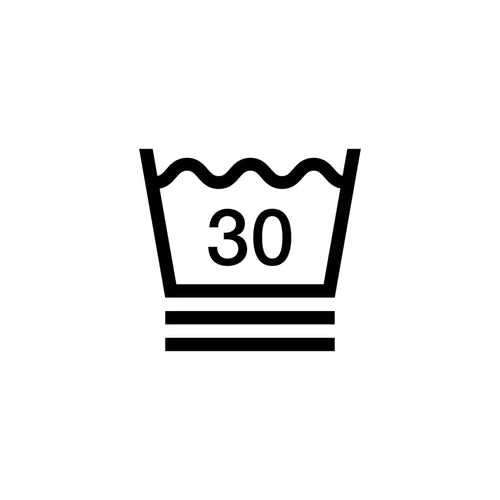INVEST IN YOUR CLOTHES
WASH WITH CARE
Timeless wardrobe classics that caress the female body season after season. That's what you can expect at LAURIE. We believe it's one of the best paths towards a more sustainable textile industry. The longer clothes are allowed to live, the less need there is to produce new ones - and the less we drain nature's resources.
The compass therefore points towards long-lasting favorites every time our designers have new styles on the drawing board. In the same spirit, we exclusively use quality materials that withstand the test of time. However, if a pair of trousers are to age gracefully, there is also a need for consideration when they reach the stage in their lifecycle where washing and drying come into play.

WE CAN LEARN FROM THE PAST
The way we treat our clothes reflects both in each individual piece of clothing and in the nature that we all share, love, and depend on. When we wash our clothes, both the garments and nature take notice. Looking back in time - to an era without washing machines, dryers, and fast fashion - there is plenty of environmentally friendly learning to be gained. Generally, the wardrobe was much smaller for individuals, and therefore, people took better care of their clothes. They washed them less frequently, washed them more gently - and for good reason, never tumble-dried them. Additionally, when wear and tear began to show, the needle and thread came out.
FIVE RECCOMENDATIONS
If you want to take better care of both your clothes and the environment, you can benefit from taking a closer look at your clothes before putting them in the washing machine. Does it smell? Is it dirty? Or does it just end up in the machine because that's where it usually goes after one or two days of wear? Most clothes can be worn many times before they actually need detergent - especially trousers, which make up the majority of LAURIE's range. The fresh air just outside your door can usually work wonders within a few hours.
The selection of environmentally friendly detergents is extensive, so when it's time to do laundry, it's worth opting for the greenest alternative. Additionally, it's worth dosing correctly. Overdosing detergent is a loss for both clothes – which risk retaining excess soap residue – the environment, and your wallet. There are dosing instructions on all detergents, so you just need to find out how hard the water is where you live.
You're probably well aware that your clothes are best sorted by color. But do you also sort them by fabric type and recommended washing temperatures? By doing so, you can extend their lifespan. Is fabric softener necessary? We use fabric softener as both a softening and scent-enhancing agent – but above all, we use it to counteract static electricity in clothes. However, static electricity only occurs in garments made of synthetic materials, and at LAURIE, we strive to use as many natural materials as possible. Because nature has a hard time breaking down fabric softener, we therefore recommend skipping it.
The shortest answer is, of course, no. We've been dressing ourselves for centuries without using tumble dryers, and we all know they are harsh on both clothes and the environment. Everything we design and produce at LAURIE is best not tumble dried - but if you're in a hurry one day, we recommend the efficient drying balls, which shorten the time in the dryer. They work by lifting and separating the clothes, allowing air to circulate better - and that's good for both the clothes, the environment, and the electricity bill.
We know from bitter experience how a washing machine can start to smell between washes if we forget to leave the door slightly ajar. This happens when the air isn't changed, and leftover water aren't allowed to evaporate. In addition to always leaving the door ajar between washes, despite the greater environmental impact, it's a good idea to run your washing machine on a hot wash a few times a month. This helps remove bacteria and built-up soap residues, and for a thorough cleaning, you can also wipe the rubber seal and wash the detergent drawer. A clean washing machine simply washes clothes better, thereby prolonging their lifespan.
WHAT DO THEY MEAN?
WASHING ICONS

TEMPERATURE
The number in the tub indicates the maximum temperature for washing the clothes.

GENTLE CYCLE
The horizontal line under the tub indicates that the clothes should be washed on a gentle cycle.

EXTRA GENTLE
"The two horizontal lines under the tub indicate that the clothes should be washed on an extra gentle cycle."

HAND WASH
"The hand in the tub means that the clothes should only be hand washed."

NO WASHING
With a cross over the tub, the clothes are not suitable for washing. Consider airing the clothes instead.

IRONING TEMPERATURE
The dot indicates the maximum temperature for ironing.

NO IRONING
The cross over the iron means that the clothes cannot be ironed. Consider hanging the clothes to dry so they smooth out.

CLEANING
The garment is suitable for dry cleaning and gentle cleaning.

NO CLEANING
The cross means that the garment cannot be dry cleaned.

FLAT DRYING
A horizontal line means that the garment should dry flat. Consider using a towel underneath.

AIR DRY
When you see one vertical line, your clothes should hang to dry. You can hang them on a clothesline or drying rack if needed.

DRIP DRY
When you see three vertical lines, your clothes should drip dry. You can hang them on a hanger if needed.

DRY IN SHADE
One or more vertical lines with a diagonal line in the corner means that the clothes should hang to dry in the shade.

TUMBLE DRY ON LOW HEAT
The clothes can be dried in a tumble dryer on low heat.
Two dots inside the circle mean that the clothes can be dried at regular temperature in a tumble dryer.

NO TUMBLE DRYING
Krydset betyder, at tøjet ikke tåler at blive tørretumblet.








